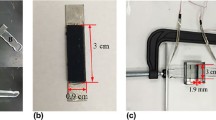Abstract
The paper investigates a carbon nanotube-based sensor to detect crack propagation in aluminum structures underneath composite patching. Initial tests are conducted to determine the correct procedure and materials to properly fabricate a carbon nanotube (CNT) based sensor, which is then placed in between a composite patch and the aluminum structure. The CNTs have been utilized as sensors in previous studies but only for sensing crack propagation within the composite itself. This study focuses on crack propagation in the base material and is not concerned with the composite. In this application, the composite is only a patch and can be replaced if damaged. The study conducts both tension and fatigue testing to determine the usefulness of the CNT sensor. The CNT sensor is shown to be effective in giving an indication of the crack propagation in the aluminum. Correlation is done between the crack propagation length and the increase in electrical resistance in the CNT sensor under tensile and cyclic loading, respectively.












Similar content being viewed by others
References
Schwarting, R., Ebel, G., Dorsch, T.: “Manufacturing techniques and process challenges with CG47 class ship aluminum superstructures modernization and repairs,” in In Fleet Maintenance and Modernization Symposium 2001: Assessing Current and Future Maintenance Strategies, San Diego, (2011)
Needham, B., Field, A.: “Sensitization of 5000 Series Al Alloys,” in Naval Surface Warfare Center Carderock Division, Corrosion and Engineering Branch, Mega Rust Report, San Diego, (2007)
Mouritz, A., Gellert, E., Burchill, P., Challis, K.: Review of adcvance composite structures for naval ships and submarines. Compos. Struct. 53, 21–44 (2001)
Calister, W.D.: “Carbon nanotubes,” in materials and engineering an introduction, p. 471. Wiley, New York (2010)
Ahwahnee: “Technical Report: How to Use Multi-Walled Carbon Nanotubes,” Ahwahnee Technology Inc, San Jose, (2005)
Gojiny, F.H., Wichmann, M.H.G., Kopke, U., Fiedler, B., Schulte, K.: Carbon nanotube-reinforced epoxy-compo sites: enhanced stiffness and fracture toughness at low nanotube content. Compos. Sci. Technol. 64, 2363–2371 (2004)
Saito,R., Dresselhaus, G.: “Physical Properties of Carbon Nanotubes,” World Scientific, pp. 11–12, 224–225, (1998)
Bily, M.A., Kwon, Y.W., Pollak, R.D.: Study of composite interface fracture and crack growth monitoring using carbon nanotubes. Appl. Compos. Mater. 17(4), 347–362 (2010)
Faulkner, S.D., Kwon, Y.W., Bartlett, S., Rasmussen, E.A.: Study of composite joint strength with carbon nanotube reinforcement. J. Mater. Sci. 44(11), 2858–2864 (2009)
Gao, L., Thostenson, E.T., Zhang, Z., Byun, J., Chou, T.: Damage monitoring fiber-reinforced composites under fatigue loading using carbon nanotube networks. Phils. Mag. 90, 4085–4099 (2010)
Gojny, F.H., Wichmann, M.H.G., Fiedler, B., Kinloch, I.A., Bauhofer, W., Windle, A.H., Schulte, K.: Evaluation and identification of electrical and thermal conduction mechanisms in carbon nonotube/epoxy composites. Polymer 47, 2036–2045 (2006)
Thostenson, E.T., Chou, T.: Real-time in situ sensing of damage evolution in advance fiber composites using carbon nanotube networks. Nanotechnology 19, 215–713 (2008)
Thostenson, E.T., Chou, T.: Processing-structure-multi-functional property relationship in carbon nanotube/epoxy composites. Carbon 44, 3022–3029 (2006)
Rosca, I.D., Hoa, S.V.: Highly conductive multiwall carbon nanotube and epoxy composites produced by three-roll milling. Carbon 47, 1958–1968 (2009)
Thostenson, E.T., Chou, T.: Carbon nanotube networks: sensing of distributed strain and damage for life prediction and self healing. Adv. Mater. 18(21), 2837–2841 (2006)
Thostenson, E.T., Ziaee, S., Chou, T.: Processing and electrical properties of carbon nanotube/vinly ester nanocomposites. Compos. Sci. Technol. 69, 801–804 (2009)
Sandler, J., Shaffer, M., Prasse, T., Bauhofer, W., Schulte, K., Windle, A.: Development of a dispersion process for carbon nanotubes in an epoxy matrix and the resulting electrical properties. Polymer 40, 5967–5971 (1999)
Zhang, W., Sakalkar, V., Koratkar, N.: In situ health monitoring and repair in composites using carbon nanotube additives. Appl. Phys. Lett. 91(13), 133102 (2007)
Li, C., Thostenson, E.T., Chou, T.: Sensors and actuators based on carbon nanotubes and their composites: a review. Compos. Sci. Technol. 68, 1227–1249 (2008)
Mahar, B., Laslau, C., Yip, R., Sun, Y.: Development of carbon nanotube-based sensor—a review. IEEE Sensors J. 7, 266–284 (2007)
Nofar, M., Hoa, S.V., Pugh, M.D.: Failure detection and monitoring in polymer matrix composites subject to static and dynamic loads using carbon nanotube networks. Compos. Sci. Technol. 69, 1599–1606 (2009)
Pro-Set Inc: Technical data, M1002 resin/237 hardener toughened laminating epoxy. Pro-Set Inc., Bay City (2005)
Instron Corporation: Test Method Development Manual, Norwood, MA: Instron Corporation, (2004)
MTS Systems Corporation: Model 793.00 System Software, Eden Prairie, MN: MTS Systems Corporation, (2000)
Author information
Authors and Affiliations
Corresponding author
Rights and permissions
About this article
Cite this article
Olson, T.M., Kwon, Y.W., Hart, D.C. et al. Carbon Nanotube Based Sensor to Monitor Crack Growth in Cracked Aluminum Structures Underneath Composite Patching. Appl Compos Mater 22, 457–473 (2015). https://doi.org/10.1007/s10443-014-9417-0
Received:
Accepted:
Published:
Issue Date:
DOI: https://doi.org/10.1007/s10443-014-9417-0




